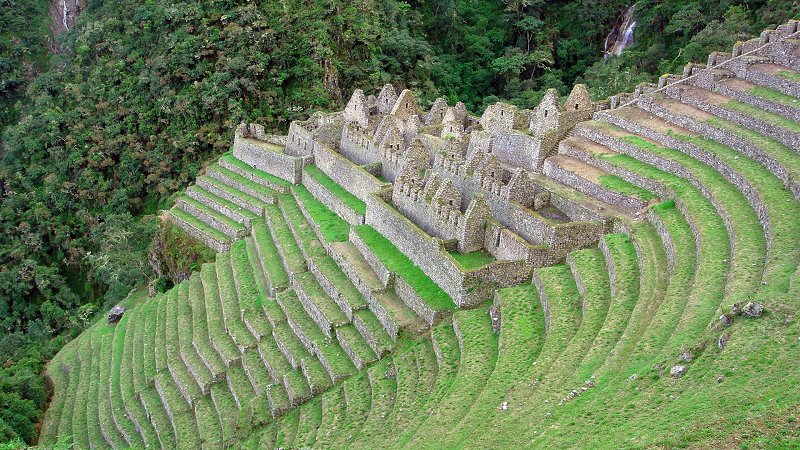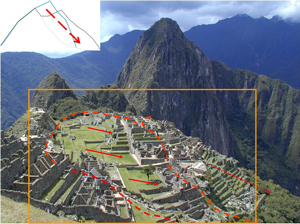Machu Picchu- became one of the new Seven Wonders of the World in the year 2007, was first discovered by Prof. Hiram Bingham in July 1911. It is situated in the northwest of Cusco, Peru. By the year 1983, it was declared as a World Heritage of Humanity in terms of both cultural and natural beauty by UNESCO. The citadel of Machu Picchu was built by the Incas in the 15th century A.D. But it collapsed by 1540 as the Spanish attacked the city and left it abandoned as centuries.
Of all the interesting things found out in this citadel, two features have caught the eyes of most of the scientists and researchers exploring the region. First one is the alignment of the rock masonry structures of the citadel; and second one is how such a citadel is standing firm on a landslide prone area affected by frequent earthquakes of higher magnitudes.
Alignment of rocks:
The alignments of rock masonry seem to be done in a random way, but researchers have told that they do maintain a geometric equation. The equations have not been found till now, but it will soon be coming into picture. The buildings were built of granite rocks which are still locally available on the banks of the river Urubamba. They were carved first in different proportions on the banks and then carried to the site. The walls of the buildings were made of uneven shaped and sized rocks. They look uneven, but are actually complement in shape to the next rock block. With the majority of Machu Picchu created using this technique it displays the excellent craftsmanship of the Inca people and how they had mastered the building technique called Ashlar. This complementary property of Ashlar helps the heavy rock blocks to stay intact even in high frequency earthquakes and landslides without the use of cement paste used in between the rocks. The stones of the dry-stone walls built by the Incas can move slightly and resettle without the walls collapsing. The walls are usually rounded with the inside corners inclined slightly into the rooms. The corners ate tied using L- shaped blocks from outside. Many junctions in the central part of citadel are so perfect that it is said not even a blade of grass fits between the stones.


Figure 2. Walls at Machu Picchu
Most of the buildings in Machu Picchu are one-storey high and rectangular shaped with trapezoidal doors and windows, but with uneven carved surfaces. This is due to the fact that they used harder rocks to carve softer ones with simple rocky tools. There is only portion of the citadel where there is differential settlement of the wall. Other than that portion, most of the citadel is perfectly intact. The different size of the rocks placed one after another, may be helping in stabilizing the buildings. There must be absence of stress points concentrations and resonant frequencies in these buildings. This very hypothesis is unknown to the researchers and scientists. A sample of the differential settlement of stone masonry structure is shown in the figure 2.
Figure 3. Differential settlement of wall
Stabilizing the citadel on a landslide prone area:
The citadel stands several metres above the valley of the River Urubamba. The region is affected by frequent landslides which are caused by earthquakes of higher magnitudes. The epicenter may not be in Machu Picchu but they lie within radius of several hundreds of kilo meters. After the recent Hawaii Earthquake of 2006, there has been a pattern of disaster in the buildings of the citadel. A few of them are –
1. Block-on-block sliding(in figure 4)
2. Wall or column bending(in figure 4)
3. Wall rupture due to differential settlement( as in figure 3)
4. Wall bulging, bending and settlement due to foundation failure at the bottom of the slope(in figure 5)
Historians and researchers tell that there had been a landslide when Inca civilization was on its peak of glory. One side of the slope was destroyed along with its wall and foundation. They re-built the structure with fine size soil on top layers and big boulders at the bottom. Thus the citadel became again.
Figure 4. Failure due to sliding and bending
Figure 5. Failure due to bending, bulging and settlement
The researchers are telling that the stability of the citadel lies in the use of locally available granite rock as building material and unique combination of uneven size and shaped rock masonry. Besides these features the roof tops of the houses were such made that they are not destroyed by high speed winds flowing on the top of the mountain. In 2005 and 2009, the University of Arkansas made detailed laser scans of the entire Machu Picchu site and of the ruins at the top of the adjacent Huayana Picchu Mountain. The university has made the scan data available online for research purposes. All these extraordinary features of Machu Picchu have made into a wonder of the world and a masterpiece of Civil Engineering during and after the Inca Civilisation.
References:
1. Brown Jeff L. (2001), “Rediscovering the lost city”, Civil Engineering magazine.
2. Medley et.al. ((2007), “Seismic Performance of Rock Block Structures with observations from the October 2006 Hawaii Earthquake”, ICEGE Greece.
3. Cardier Beth (2009), “Seismic Semantic Federation:The view from Machu Picchu”, University of Melbourne, Australia.
4. Sassa Kyoji, Fukuoka Hiroshi, Shuzui Haruo, Hoshino Minoru (2003), “Landslide risk evaluation in the Machu Picchu World Heritage, Cusco, Peru”, Japan.









